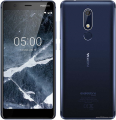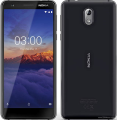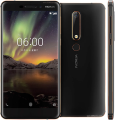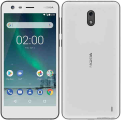Nokia Lumia 820 Prices
Important Note.
- All prices are in Pakistani Rupee (PKR)
- Prices may vary at stores and our effort will be to provide you with the updated prices.
- The latest price of Nokia Lumia 820 was obtained on 31 جنوری, 2018. The prices at the original stores had been updated on the respective mentioned dates.
- Find out WhatMobile price has dropped in Pakistan by selecting Notify Price Drop button
- Find out WhatMobile has better specifications by clicking Add To Compare Button find out what Mobile has better reviews by visiting our reviews section
- Find out WhatMobile is cheaper on which retailer by clicking Compare prices from retailers button
Search Terms
- Nokia Lumia 820
Specifications
| GENERAL | |
| 2G Network | GSM 850 / 900 / 1800 / 1900 |
|---|---|
| 3G Network | HSDPA 850 / 900 / 1900 / 2100 |
| Sim | Micro-SIM |
| Announced | 09/01/2012 |
| Status | Available. Released 2012, November |
| BODY | |
| Dimensions | 123.8 x 68.5 x 9.9 mm, 83.5 cc (4.87 x 2.70 x 0.39 in) |
| Weight | 160 g (5.64 oz) |
| DISPLAY | |
| Display Size | 480 x 800 pixels, 4.3 inches (~217 ppi pixel density) |
| MultiTouch | Yes |
| SOUND | |
| AlertTypes | Vibration; MP3, WAV ringtones |
| LoudSpeaker | Yes |
| 3.5mm jack | Yes |
| MEMORY | |
| CardSlot | microSD, up to 64 GB |
| Internal | 8 GB, 1 GB RAM |
| DATA | |
| GPRS | Class 12 (4+1/3+2/2+3/1+4 slots), 32 - 48 kbps |
| EDGE | Class 12 |
| Speed | HSDPA, 42 Mbps; HSUPA, 5.76 Mbps; LTE, Cat3, 50 Mbps UL, 100 Mbps DL |
| WLAN | Wi-Fi 802.11 a/b/g/n, dual-band, Wi-Fi Direct |
| Blue Tooth | Yes, v3.1 with A2DP, EDR/ v4.0 LE after WP8 Black update |
| USB | Yes, microUSB v2.0 |
| CAMERA | |
| Camera Primary | 8 MP, 3264 x 2448 pixels, Carl Zeiss optics, autofocus, dual-LED flash |
| Camera Features | Geo-tagging, touch focus |
| CameraVideo | Yes, 1080p@30fps, video stabilization |
| CameraSecondary | Yes, VGA |
| FEATURES | |
| Processor Cores | Dual-Core |
| OS | Microsoft Windows Phone 8, upgradeable to WP8 Black |
| CPU | Dual-core 1.5 GHz Krait |
| Sensors | Accelerometer, gyro, proximity, compass |
| Messaging | SMS (threaded view), MMS, Email, Push Email, IM |
| Browser | HTML5 |
| Radio | FM radio |
| GPS | Yes, with A-GPS support and GLONASS |
| Java | No |
| Colors | Black, Gray, Red, Yellow, White, Blue, Violet |
| Others | - SNS integration - Active noise cancellation with dedicated mic - 7GB free SkyDrive storage - MP3/WAV/eAAC+/WMA player - MP4/H.264/H.263/WMV player - Document viewer - Video/photo editor - Voice memo/command/dial - Predictive text input |
| BATTERY | |
| Battery | Li-Ion 1650 mAh battery (BP-5T) |
| StandBy | Up to 330 h (2G) / Up to 330 h (3G) |
| TalkTime | Up to 14 h (2G) / Up to 8 h (3G) |
| MISC | |
| SARUS | 1.37 W/kg (head) 0.71 W/kg (body) |
| SAREU | 0.79 W/kg (head) |
Reviews
Price: £400
Rating: 0

Microsoft, now the owner of Nokia, unveiled the Nokia Lumia 830 in September at the IFA conference in Berlin, alongside the Nokia Lumia 630, Nokia Lumia 635 and Nokia Lumia 930. The new mid-range smartphone replaces its two-year-old predecessor, the Nokia Lumia 820. But how do the two smartphones compare? Find out in our Nokia Lumia 820 vs Nokia Lumia 830 comparison. See also: Best smartphones 2014
Nokia Lumia 820 vs Nokia Lumia 830: Price
Now that it's a generation old, the Lumia 820 has been discontinued by Microsoft and Nokia, but if you really want to buy it you'll be able to pick it up from eBay for around £150. We'd recommend purchasing one of the newer budget smartphones if a £150 price tag is more within your reach, such as the Motorola Moto G.
If you're considering buying the Nokia Lumia 830, you can pick it up Sim-free for around £300, putting this smartphone firmly in the mid-range category with rivals including the OnePlus One, HTC Desire 610 and the Sony Xperia M2.
Nokia Lumia 820 vs Nokia Lumia 830: Design and build

At first glance, the Nokia Lumia 820 and Lumia 830 look quite similar, with a squared, blocky design. On closer inspection, though, it quickly becomes clear that the Nokia Lumia 830 has a much sleeker and more sopisticated design, with thinner bezels, a new rounded camera housing on the rear and new colour options. It's available in orange, green, white or black, whereas the Lumia 820 is available in red, yellow, blue, purple, grey white or black.
The newer smartphone is much thinner than its predecessor, at 8.5mm compared with the 9.9mm of the Lumia 820. They have different proportions overall, too: the 830 is 139.4 x 70.7mm while the 820 is 123.8 x 68.5mm.

That's thanks to much to much thinner bezels around the edges of the Lumia 830, which manages to house a 5in screen rather than the 4.3in screen of its predecessor. The screen is now made with the more durable Gorilla Glass 3, too.
Nokia has also managed to make the Lumia 830 a bit lighter than the Lumia 820, at 150g compared with 160g.
Nokia Lumia 820 vs Nokia Lumia 830: Screen

As mentioned above, the Lumia 830 offers a 5in screen, much bigger than the 4.3in screen of the Lumia 820. The Lumia 830's screen is an IPS LCD with ClearBlack technology, so boasts better viewing angles than the 820's AMOLED screen.

The resolution has been improved, too, now HD 720p rather than the WVGA of the Lumia 820 (that's 1280 x 720 vs 800 x 480, to be precise), so that means a higher pixel density of 294ppi compared with 217ppi. You'll get a much better experience watching videos with the Lumia 830, that's for sure.
Nokia Lumia 820 vs Nokia Lumia 830: Processor, graphics and performance
Both the Lumia 820 and Lumia 830 have 1GB of RAM. The Lumia 830's processor is new, though. It's a 1.2GHz quad-core Qualcomm Snapdragon 400 processor which is found in lots of recent mid-range and budget smartphones so should be pretty speedy.
The Lumia 820 has an older and less powerful 1.5Ghz dual-core Qualcomm Snapdragon S4 Plus MSM8960 chip.
Graphics have been improved, too. The Lumia 820 has Adreno 225 graphics while the Lumia 830 has the newer Adreno 305 so playing games should be smoother and much more satisfying.
Nokia Lumia 820 vs Nokia Lumia 830: Storage and connectivity

Built-in to the Nokia Lumia 830 is 16GB of memory, double that of the Lumia 820. You'll find a microSD slot in the Lumia 830 that lets you add up to 128GB extra storage and a microSD slot in the Lumia 820 that lets you add up to 64GB extra storage.
The Lumia 830 and Lumia 820 share many of the same connectivity features, including Bluetooth 4.0, NFC and 4G LTE, but the Nokia Lumia 830 adds support for wireless charging.
Nokia Lumia 820 vs Nokia Lumia 830: Cameras

Nokia has improved the camera in the Lumia 830, which has a 10Mp sensor rather than the 8Mp sensor in the Lumia 820. They both have auto focus and a 4x digital zoom, though, and both have an aperture of f/2.2.
Nokia has also added optical image stabilisation to the Lumia 830, which will be a real boon for smartphone photographers.
When it comes to video, both of these smartphones can shoot 1080p at 30fps, and as for the front-facing camera, they're both disappointing at under 1Mp each.
Nokia Lumia 820 vs Nokia Lumia 830: Software

Both the Lumia 820 and Lumia 830 smartphones run Windows Phone, but the newer smartphone has version 8.1 with Microsoft Office, OneDrive and Cortana built-in and the new Lumia Denim UI interface.
Nokia Lumia 820 vs Nokia Lumia 830: Battery life
Nokia claims that the battery life of the Lumia 830 is a huge improvement over the Lumia 820. It touts 22 days maximum standby time for the 830 compared with 15 days for the 820, and 14.8 hours maximum talk time compared with 8.1 hours.
That's in part thanks to a bigger battery, at 2200 mAh compared with the Lumia 820's 1650mAh.
Nokia Lumia 820 vs Nokia Lumia 830: Verdict
Overall, the Nokia Lumia 830 is a huge improvement over its predecessor, with spec bumps in almost every area possible. It's speedier, can capture better photographs, offers a much better and bigger screen and has a significantly more attractive design, in addition to the extra storage space and newer software. We'd still recommend checking out other mid-range smartphones before making your purchasing decision, though, as the Lumia 830 has some solid rivals from competing companies.
Buying Advice
Overall, the Nokia Lumia 830 is a huge improvement over its predecessor, with spec bumps in almost every area possible. It's speedier, can capture better photographs, offers a much better and bigger screen and has a significantly more attractive design, in addition to the extra storage space and newer software. We'd still recommend checking out other mid-range smartphones before making your purchasing decision, though, as the Lumia 830 has some solid rivals from competing companies.Write Your Own Review
My Recent Reviews
- Be first to post review for this product.
comments powered by Disqus















-32-GB.jpg)
-64-GB.jpg)













